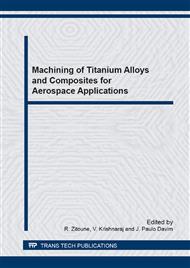p.1
p.29
p.51
p.65
p.91
p.107
p.127
p.145
Influence of Tool Geometry and Machining Parameters on the Surface Quality and the Effect of Surface Quality on Compressive Strength of Carbon Fibre Reinforced Plastic
Abstract:
In this chapter the influence of tool geometry and cutting conditions on cutting forces, surface defects and the percetage of dust generated durring trimming and reaching the pulmonary alveoli is investigated. The surface defects were analysed using a scanning electron microscope and diferent surface roughness measurement devices. It was observed that these leters were highly depend on the cutting condition and the tool geometry, and more important that the effect of cutting parameters can be completely diferent from a tool to an other or even when considering different ranges of cutting parameters (standard cutting speed and high cutting speed). The compressive strenght after machining is also investigated. It is observed that whatever tool geometry, cutting conditions, surface roughnesses (defects) are, the response still the same for all the composite samples except for those machined at cutting temperatures higher than the glass fiber transition.
Info:
Periodical:
Pages:
107-125
Citation:
Online since:
July 2013
Authors:
Price:
Сopyright:
© 2013 Trans Tech Publications Ltd. All Rights Reserved
Share:
Citation:


